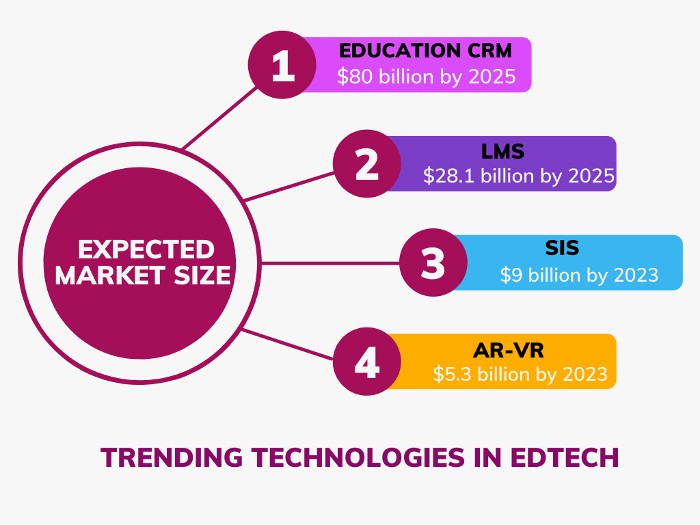Future of Ed-Tech with Automation
Global Ed-Tech market is projected to increase from USD 98.19 billion in 2021 to USD 302.46 billion in 2028 at a CAGR of 17.4% as per Fortune Business Insights. About 3% of the global education expenditure is invested towards digitalization of the industry as per HolonIQ, the education intelligence provider. With such massive investment, further advanced technology adoption is seen as a game changer in the ed-tech sector. In this article, we discuss trending tools around automation in ed-tech.
Evolution of Ed-Tech
Forbes suggests that e-learning enables students to retain knowledge better. Retention rate of learners increases from 25% to a whopping 60% with the use of tech while imparting information. But, lower cost of e-learning course material and increasing penetration of mobile and Internet are the key driving factors in the growth of ed-tech. Further the Ed-Tech sector has evolved considerably since the COVID-19 pandemic situation due to lockdown constraints. Some of the changes in education sector include:
- E-learning has gained further acceptance to become the normal way of learning
- Online Whiteboard tools are fast replacing physical blackboard education.
- Instructors are increasing their online presence with their own e-learning platform to share the digital courses with video resources
- BYOD to continue and remain mainstream
Ed-Tech revolution has impacted three core education sectors:
- K-12 education where EdTech start-ups that focus on honing skill development such as teaching programming or coding
- Post-secondary education where the focus remains on moving outside the regular course curriculum.
- Corporate training where the focus is on short-term courses, upskilling professionals, and corporate training modules.
Ed-Tech across globe
There have been tremendous government and private sector aided projects to deepen the ed-tech revolution around the globe. For instance in India, government-led initiatives such as Digital India and Literacy Growth Projects have fueled smart education demand. Europe regional market growth comes third in line, according to Fortune Business Insights. In the American and European region, there is a wider adoption of digital education and e-learning tools and technologies across educational campuses of all age-groups and corporations.
Trending Technologies: Automation and Beyond
Ed-Tech companies are heavily reliant on automation and technology to deliver end-to-end results. This starts from enrolling students, to creating and delivering the courses, to managing the continuing learning process. While Customer Relationship Management (CRM), Learning Management System (LMS), and Student Information Management (SIS) are key tools for improving the overall process through automation, whiteboard and AR-VR (Virtual Reality) like engaging and interactive technologies are key technologies to facilitate enhanced learning.
The market size of CRM is predicted at $80 billion in the next three years, according to LeadSquared study. The adoption rate of cloud-based CRM is 87% in comparison with on-premise CRM in the last few decades. The LMS market is projected at a market size of $28.1 billion by 2025-end with North America leading by geographical region. Leading LMS providers include BrightSpace, Blackboard, Moodle, and Canvas. SIS market share is predicted at USD 9.0 billion by 2023, according to MarketsandMarkets report, reflecting 12.4% CAGR from 2018.
Some of the top vendors in this segment include Skyward, Workday, SAP, Oracle, Illuminate Education, and Ellucian. The market size of Augmented Reality is likely to cross $5.3 billion by 2023, and it has more scope than virtual reality due to easier adaptability on smartphones. Fig. 1 below shows the expected market size of these trending technologies in Ed-Tech.

Some of the top technology trends around automation and AI in the Ed-Tech industry can be listed as:
- Using augmented reality and virtual reality for experiential and experimental learning.
- Mobile tech offers compressed and customized apps for letting learners access study material anywhere and anytime.
- Smart classroom hardware or interactive whiteboard platform
- Innovative video learning, which enables knowledge imparting with better conceptualization. This also enables learners to retain information for longer, and better.
- Artificial Intelligence implementations for automation like face recognition which makes attendance in online examinations easier and automated.
- Adaptive and Personalized learning through online courses enables learners to self-assess their performance and helps educators design courses according to learner’s pace.
- Robotics is a practical and flexible approach for learners with disabilities.
- Gamification helps develop and increase learner’s interest and makes learning fun and relevant.
- Big Data enables institutions and schools to understand underlying user data and analytics at scale and helps update their content and courses with learners requirements on the go.
- Blockchain technology allows unrestricted data storage, and making data transactions transparent and decentralized
Conclusion
With exponential growth predicted in the ed-tech market, automation and other technologies are going to help the educational institutions and instructors further. Personalization, better time management, and ease of accessibility implemented through technology have made education more agile and scalable across the globe.




